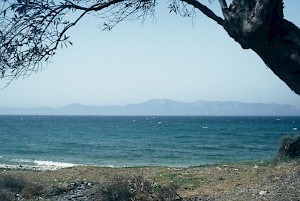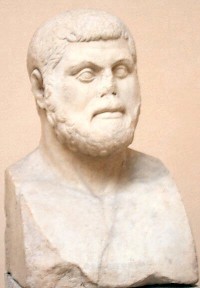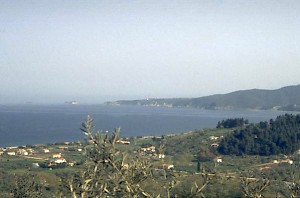Artemisium (480 BCE)
Q747679Artemisium (Greek Ἀρτεμίσιον): northern cape of the isle of Euboea, well known for a the naval battle in which the navy of the united Greeks was unable to black the advance of the Persian naval forces (480 BCE).

In Antiquity, the name "Artemisium" was given to the coast of Euboea opposite Magnesia. Cape Artemisium is more or less the northernmost part of the island.
It is the place where the united Greek navy in the summer of 480 tried to block the advance of the fleet of the Persian king Xerxes, who was invading Greece. The story is told by Herodotus.note
After careful preparations, the Persians had decided to attack the Yaunâ (Greeks) in the summer of 480 with a very large army. The Greeks, officially commanded by the Spartan Eurybiades, but in fact by the Athenian Themistocles, understood that they had to annihilate the Persian transport fleet; without its support, the army would be forced to return. Of course, the Persians protected their transport ships with a navy of triereis.

The Greeks now attempted to stop the Persian fleet at Cape Artemisium with a navy that consisted of 271 triereis; at the same time, they blocked the advance of the Persian army at Thermopylae. The two sites were connected: if Thermopylae fell, the Persian cavalry could proceed to Chalcis, cross to Euboea, and attack the Greek navy at Artemisium in the rear; at the same time, the Persian navy could sail around Euboea and attack the defenders of Thermopylae. However, a flotilla that attempted this maneuver, was lost in a storm at a place called the "Hollows of Euboea".
The Persians, who had suffered some losses in a storm during their advance from Therma (now Thessaloniki) to the south, occupied Aphetae on Cape Magnesia (where the legendary Argo had once departed from Greece), but their fleet was very large, which made it hard to keep them together. Fifteen ships lost contact with the main force, and were captured by the Greeks. Still, the greater part landed at Aphetae, although the units were situated at some distance of each other - there were simply too many Persian ships at Magnesia.

During the first two days of the encounter, the Greeks could attack units separately, and had some success: on the first day, they captured 30 enemy ships, and on the second day, the destroyed the flotilla of the Cilicians, who served the Persian king.
However, on the third day, the Persians came out at full strength and beat the Greeks, who now had to leave Artemisium. (Herodotus presents it as a Greek victory, but cannot hide that the Greeks suffered heavily.)
At the same time, king Xerxes had defeated the Greek land army, commanded by the Spartan king Leonidas, at Thermopylae. It seemed as if Greece had fallen. However, during the naval battle of Artemisium, many Persian ships had sunk in a violent storm. This picture shows the 'hollows' of Euboea, where they met the disaster. In September, the Persian navy had become too small and the Greeks could overcome their enemies during the naval battle of Salamis.